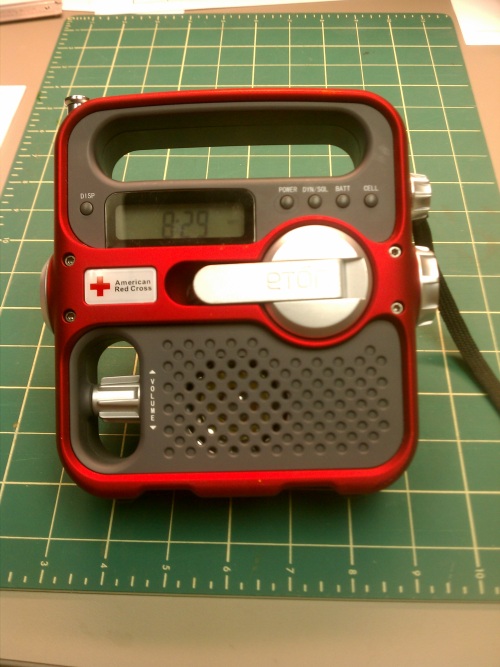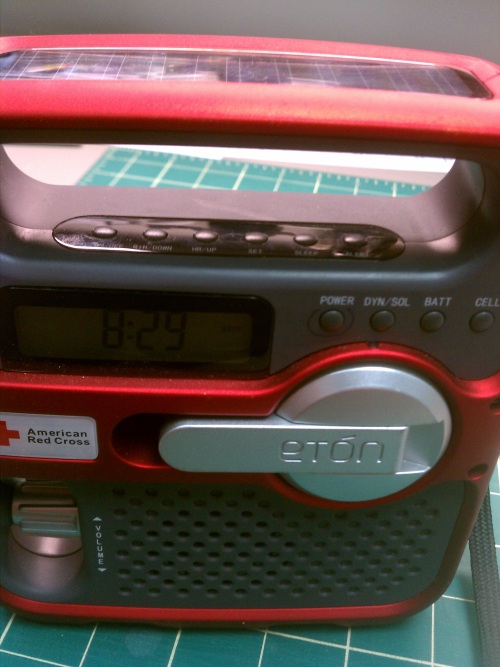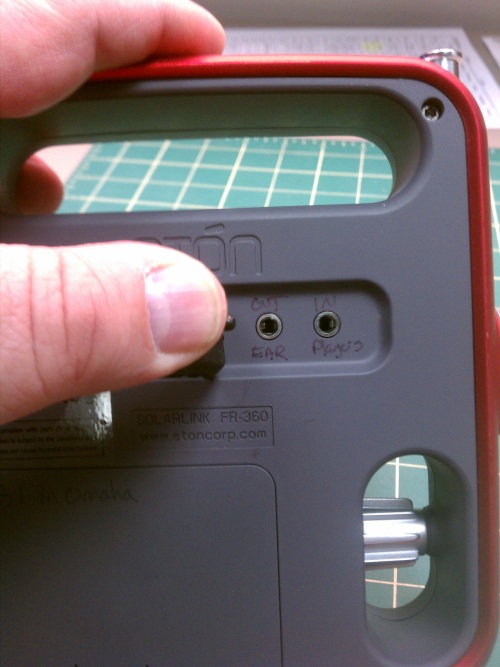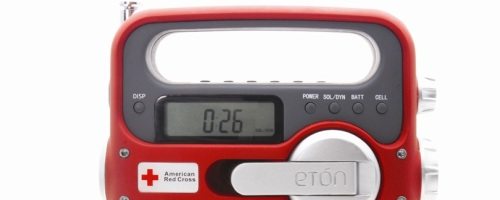After reviewing the Eton/Red Cross Aluminator Flashlight , I was happy to receive an Eton/Red Cross ARCFR360R SolarLink Emergency Radio as a gift. Being a preparedness-minded kinda gadgeteer, I was really looking forward to adding this feature-filled gadget to my kit.
Note: This is a 2nd opinion on this product. Janet reviewed the ETON Solarlink last Spring.
The Eton ARCFR360R is almost ridiculously full of features.
- It can run off 3 AAA batteries (not included), AC power (adapter not included), solar power (sort of), or a hand crank. The latter two charge a replaceable bank of Ni-Mh coin cells, like those used in cordless phones.
- The radio can pick up AM, FM, and 7 NOAA weather bands- with digital tuning.
- It has a alarm, sleep to music, a USB charger port (cable not included), 4 LED flashlight- white or red flashing, and has a headphone out jack, as well as a source input jack (cables not included).
- There is a digital display, 11 small buttons, a big switch (for the flashlight), 3 knobs, and 4 ports or jacks.
It claims to be a rugged, reliable, award-winning unit for everyday preparedness. It all really sounds great!

Functionally, the flashlight works well- nothing special, but handy. The radio works decently on all bands. Clarity and volume are about what you get out of most smaller battery-powered mono radios with a typical antenna. The digital tuning is helpful, and the large tuning dial makes it easy to either make big spins or fine-tune. There is a tendency sometimes for the tuner to hesitate or jump in use but this is nothing too annoying.
The weather radio is helpful. Most people will only be able to pick up one channel in their areas (I made a note of which channel ours was on the back of the unit.) It does feature an ALERT option that will trigger a tone on the radio when the local weather service issues one- as long as their is a charge in the batteries.

The buttons. The radio is covered in small buttons with tiny labels. 4 in one group on the front, one off to the side, and a bank of 6 under the handle. Even in decent light, the buttons under the handle are hard to read. The ‘DISPLAY’ button (off to the side) triggers a very short-lived backlight for the display that also helps illuminate the button labels, but you better read fast. The bank of four help manage the power functions-“POWER, SOL/DYN, BATTERY, CELL”. To turn the unit on or off, select SOL/DYN or BATTERY and POWER. CELL turns on the USB charger. The other buttons, under the handle are for things like “ALERT, ALARM, SLEEP, CLOCK”, etc.
The helpful booklet explains how to do everything, but some things are not as smoothly intuitive as they could be so you’ll want to keep the booklet handy. And, remember, you may be doing these functions in the dark in adverse conditions. Yuck.
The crank and solar panels are big sales points in emergency units- the ability to run the unit if all else fails. But it takes about 3 minutes of cranking (fast enough to turn a small LED green) to power a typical call, or 90 seconds to get 15 minutes of radio play. The solar panel, like so many small solar units, takes a very long time to fully charge the Ni-Mh cells. The good news is that either the crank or the solar panels can charge those batteries- although they do not seem to hold much of a charge, or for very long (almost every time I check my radio in the prep bag, it is dead flat again. The 3 AAA batteries also do not hold up for long- less than a day of light use – possibly because it is so easy to accidentally leave something on that draws some current. I recommend keeping the batteries out of it in storage.
Once you start to get annoyed at a product, it is easy to find more and more that bothers you- the oddly placed and protected volume knob, the fact that the alarm is just the radio- set at whatever volume you went to sleep with it at (not nearly loud enough for me!), the fact the ports in back are not clearly labeled, the somewhat cheap-feeling casing, the rather exposed buttons that can get bumped in any kind of bag, and the fact that I had a hard time using the device as a radio in my nice, calm, non-crisis bedroom.

Can it be redeemed? Sure- there are things you can do to make it more useful in an emergency, or just for camping or something…
- Keep the batteries out of it until needed. This is good advice for most battery-powered devices in your emergency kit. It is also helpful to try to run all of your devices on the same size battery whenever practical.
- Instead of hiding the unit in your emergency kit, park it where the solar panel can keep charged.
- Write important notes on the case- what the ports are for, what kind of AC adapter do you need, what weather band works locally, how to turn things off, etc.
- Pack an AC charger 9for the Ni-Mh cells), and a cell phone cable for your phone with the radio.
I know that many preparedness enthusiasts prefer to use discrete components- like a small travel alarm clock, a good flashlight or three, and a hand-held AM/FM/weather radio- for many reasons and I tend to agree with them. However, there is a place for well-designed multi-purpose emergency units like this that can coordinate a variety of power options for a variety of functions. I just am not sure that this unit accomplishes it in the right way.
Eton makes some great products, like the Raptor or Scorpion radios, and Amazon lists several interesting alternatives, many with better reviews, more features, and lower prices. This unit is not a complete failure, but rather expected better from the company.
Gerber Gear 22-47162N Fast Draw Folding Assisted Opening Pocket Knife, Fine Edge, Black
$42.73 (as of December 13, 2025 18:02 GMT -05:00 - More infoProduct prices and availability are accurate as of the date/time indicated and are subject to change. Any price and availability information displayed on [relevant Amazon Site(s), as applicable] at the time of purchase will apply to the purchase of this product.)Gerber Gear EVO Jr. Folding Knife - Serrated Edge [22-41493]
$28.99 (as of December 13, 2025 18:01 GMT -05:00 - More infoProduct prices and availability are accurate as of the date/time indicated and are subject to change. Any price and availability information displayed on [relevant Amazon Site(s), as applicable] at the time of purchase will apply to the purchase of this product.)Product Information
| Price: | $50 |
| Manufacturer: | Eton Corporation |
| Retailer: | Amazon.com and others |
| Pros: |
|
| Cons: |
|




Gadgeteer Comment Policy - Please read before commenting
usleless “pseudo-rescue” pricey gadget, that trying to be feature-rich.
*useless
I own a non-solar earlier version of this radio. I have used it in non-emergency power outages in the past. I thought it worked rather well. Easily powered by the hand crank. It kept me both informed and entertained while the power was out. I do believe that my version also picked up shortwave signals. Though I have a separate battery powered shortwave handheld unit as well. Plus around a 100+ LED flashlights…
Mark
What’s in your “Kit”?
I’m always interested in what folks have set up if an emergency should come along. Is your “Kit” in a backpack ready to be on the move, you know like grab it while you’re running out the door? Do you also have one in the trunk of your car?
I think it would be neat to see what all the writers of The Gadgeteer and readers have ready for an emergency 🙂
@Bob- I have several kits. A car kit designed for weather emergencies, quick ‘refreshing’ (toiletries, etc.), traveling comfort, and supporting other kits; a tornado/disaster kit with the radio reviewed and some other items, and a sort of light-duty bug-out bag (food, water, shelter, fire, tools)
The ingredients in each fluctuates depending on the season and mood, but I find myself going rather minimal on kits in recent years for many reasons.
If other Gadgeteers want to post full lists, I am certainly willing to play!